Wine Industry of China: Analysis and Evaluation
VerifiedAdded on 2022/11/10
|7
|1478
|55
AI Summary
This report analyzes and evaluates the wine industry of China in terms of macroeconomic conditions like general business environment, economic growth, inflation, and exchange rate regime. It also discusses the impact of these factors on the domestic wine market of China.
Contribute Materials
Your contribution can guide someone’s learning journey. Share your
documents today.
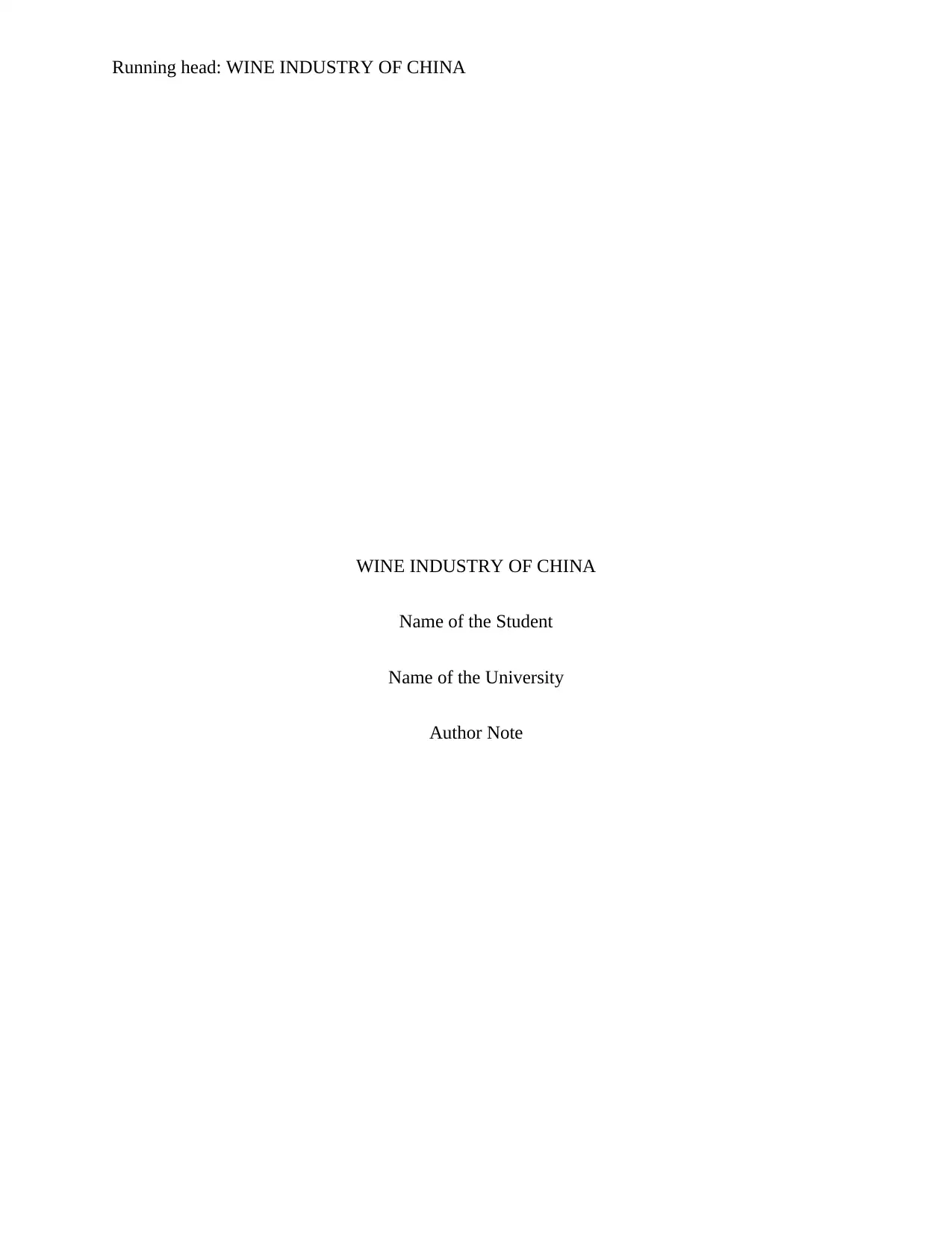
Running head: WINE INDUSTRY OF CHINA
WINE INDUSTRY OF CHINA
Name of the Student
Name of the University
Author Note
WINE INDUSTRY OF CHINA
Name of the Student
Name of the University
Author Note
Secure Best Marks with AI Grader
Need help grading? Try our AI Grader for instant feedback on your assignments.
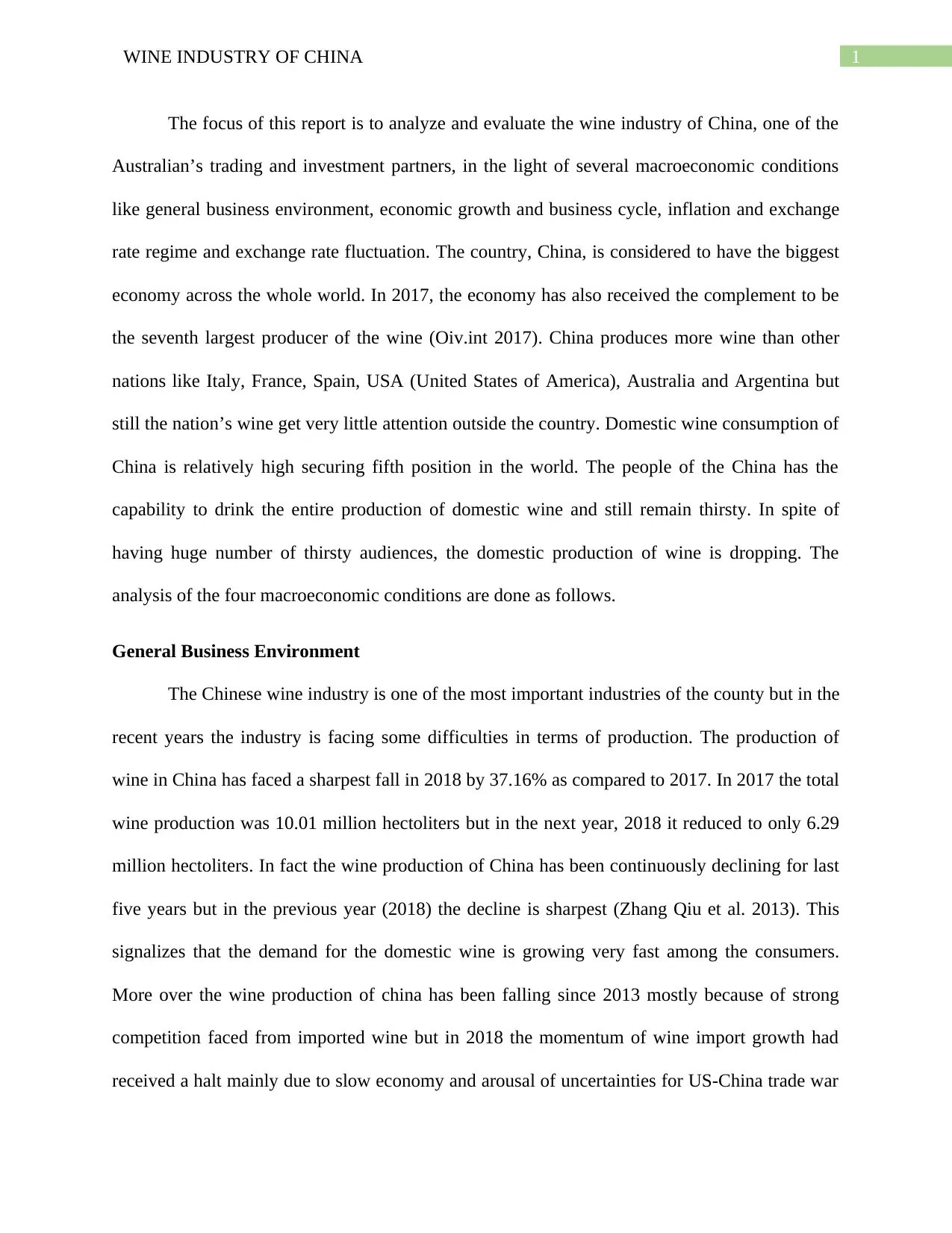
1WINE INDUSTRY OF CHINA
The focus of this report is to analyze and evaluate the wine industry of China, one of the
Australian’s trading and investment partners, in the light of several macroeconomic conditions
like general business environment, economic growth and business cycle, inflation and exchange
rate regime and exchange rate fluctuation. The country, China, is considered to have the biggest
economy across the whole world. In 2017, the economy has also received the complement to be
the seventh largest producer of the wine (Oiv.int 2017). China produces more wine than other
nations like Italy, France, Spain, USA (United States of America), Australia and Argentina but
still the nation’s wine get very little attention outside the country. Domestic wine consumption of
China is relatively high securing fifth position in the world. The people of the China has the
capability to drink the entire production of domestic wine and still remain thirsty. In spite of
having huge number of thirsty audiences, the domestic production of wine is dropping. The
analysis of the four macroeconomic conditions are done as follows.
General Business Environment
The Chinese wine industry is one of the most important industries of the county but in the
recent years the industry is facing some difficulties in terms of production. The production of
wine in China has faced a sharpest fall in 2018 by 37.16% as compared to 2017. In 2017 the total
wine production was 10.01 million hectoliters but in the next year, 2018 it reduced to only 6.29
million hectoliters. In fact the wine production of China has been continuously declining for last
five years but in the previous year (2018) the decline is sharpest (Zhang Qiu et al. 2013). This
signalizes that the demand for the domestic wine is growing very fast among the consumers.
More over the wine production of china has been falling since 2013 mostly because of strong
competition faced from imported wine but in 2018 the momentum of wine import growth had
received a halt mainly due to slow economy and arousal of uncertainties for US-China trade war
The focus of this report is to analyze and evaluate the wine industry of China, one of the
Australian’s trading and investment partners, in the light of several macroeconomic conditions
like general business environment, economic growth and business cycle, inflation and exchange
rate regime and exchange rate fluctuation. The country, China, is considered to have the biggest
economy across the whole world. In 2017, the economy has also received the complement to be
the seventh largest producer of the wine (Oiv.int 2017). China produces more wine than other
nations like Italy, France, Spain, USA (United States of America), Australia and Argentina but
still the nation’s wine get very little attention outside the country. Domestic wine consumption of
China is relatively high securing fifth position in the world. The people of the China has the
capability to drink the entire production of domestic wine and still remain thirsty. In spite of
having huge number of thirsty audiences, the domestic production of wine is dropping. The
analysis of the four macroeconomic conditions are done as follows.
General Business Environment
The Chinese wine industry is one of the most important industries of the county but in the
recent years the industry is facing some difficulties in terms of production. The production of
wine in China has faced a sharpest fall in 2018 by 37.16% as compared to 2017. In 2017 the total
wine production was 10.01 million hectoliters but in the next year, 2018 it reduced to only 6.29
million hectoliters. In fact the wine production of China has been continuously declining for last
five years but in the previous year (2018) the decline is sharpest (Zhang Qiu et al. 2013). This
signalizes that the demand for the domestic wine is growing very fast among the consumers.
More over the wine production of china has been falling since 2013 mostly because of strong
competition faced from imported wine but in 2018 the momentum of wine import growth had
received a halt mainly due to slow economy and arousal of uncertainties for US-China trade war
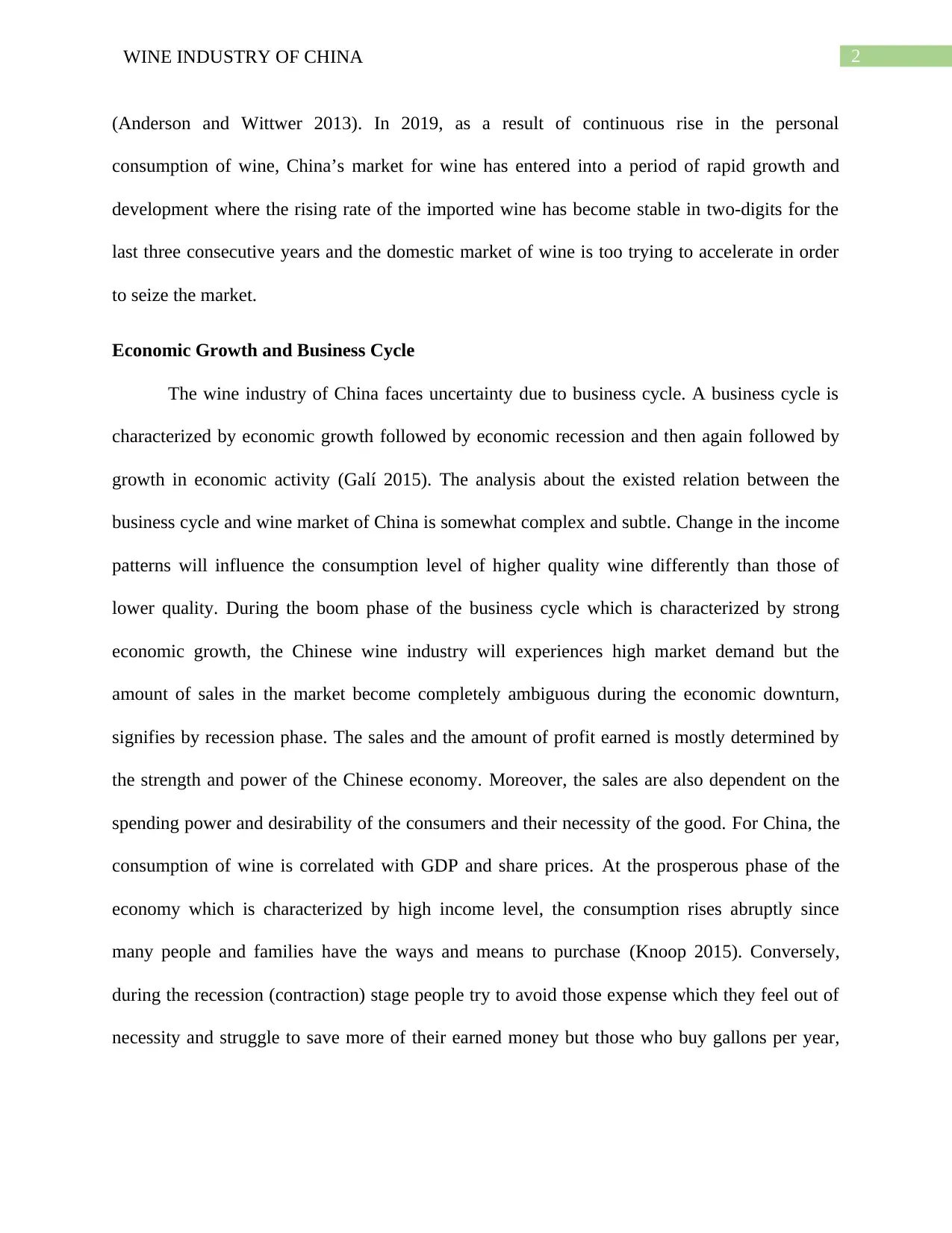
2WINE INDUSTRY OF CHINA
(Anderson and Wittwer 2013). In 2019, as a result of continuous rise in the personal
consumption of wine, China’s market for wine has entered into a period of rapid growth and
development where the rising rate of the imported wine has become stable in two-digits for the
last three consecutive years and the domestic market of wine is too trying to accelerate in order
to seize the market.
Economic Growth and Business Cycle
The wine industry of China faces uncertainty due to business cycle. A business cycle is
characterized by economic growth followed by economic recession and then again followed by
growth in economic activity (Galí 2015). The analysis about the existed relation between the
business cycle and wine market of China is somewhat complex and subtle. Change in the income
patterns will influence the consumption level of higher quality wine differently than those of
lower quality. During the boom phase of the business cycle which is characterized by strong
economic growth, the Chinese wine industry will experiences high market demand but the
amount of sales in the market become completely ambiguous during the economic downturn,
signifies by recession phase. The sales and the amount of profit earned is mostly determined by
the strength and power of the Chinese economy. Moreover, the sales are also dependent on the
spending power and desirability of the consumers and their necessity of the good. For China, the
consumption of wine is correlated with GDP and share prices. At the prosperous phase of the
economy which is characterized by high income level, the consumption rises abruptly since
many people and families have the ways and means to purchase (Knoop 2015). Conversely,
during the recession (contraction) stage people try to avoid those expense which they feel out of
necessity and struggle to save more of their earned money but those who buy gallons per year,
(Anderson and Wittwer 2013). In 2019, as a result of continuous rise in the personal
consumption of wine, China’s market for wine has entered into a period of rapid growth and
development where the rising rate of the imported wine has become stable in two-digits for the
last three consecutive years and the domestic market of wine is too trying to accelerate in order
to seize the market.
Economic Growth and Business Cycle
The wine industry of China faces uncertainty due to business cycle. A business cycle is
characterized by economic growth followed by economic recession and then again followed by
growth in economic activity (Galí 2015). The analysis about the existed relation between the
business cycle and wine market of China is somewhat complex and subtle. Change in the income
patterns will influence the consumption level of higher quality wine differently than those of
lower quality. During the boom phase of the business cycle which is characterized by strong
economic growth, the Chinese wine industry will experiences high market demand but the
amount of sales in the market become completely ambiguous during the economic downturn,
signifies by recession phase. The sales and the amount of profit earned is mostly determined by
the strength and power of the Chinese economy. Moreover, the sales are also dependent on the
spending power and desirability of the consumers and their necessity of the good. For China, the
consumption of wine is correlated with GDP and share prices. At the prosperous phase of the
economy which is characterized by high income level, the consumption rises abruptly since
many people and families have the ways and means to purchase (Knoop 2015). Conversely,
during the recession (contraction) stage people try to avoid those expense which they feel out of
necessity and struggle to save more of their earned money but those who buy gallons per year,
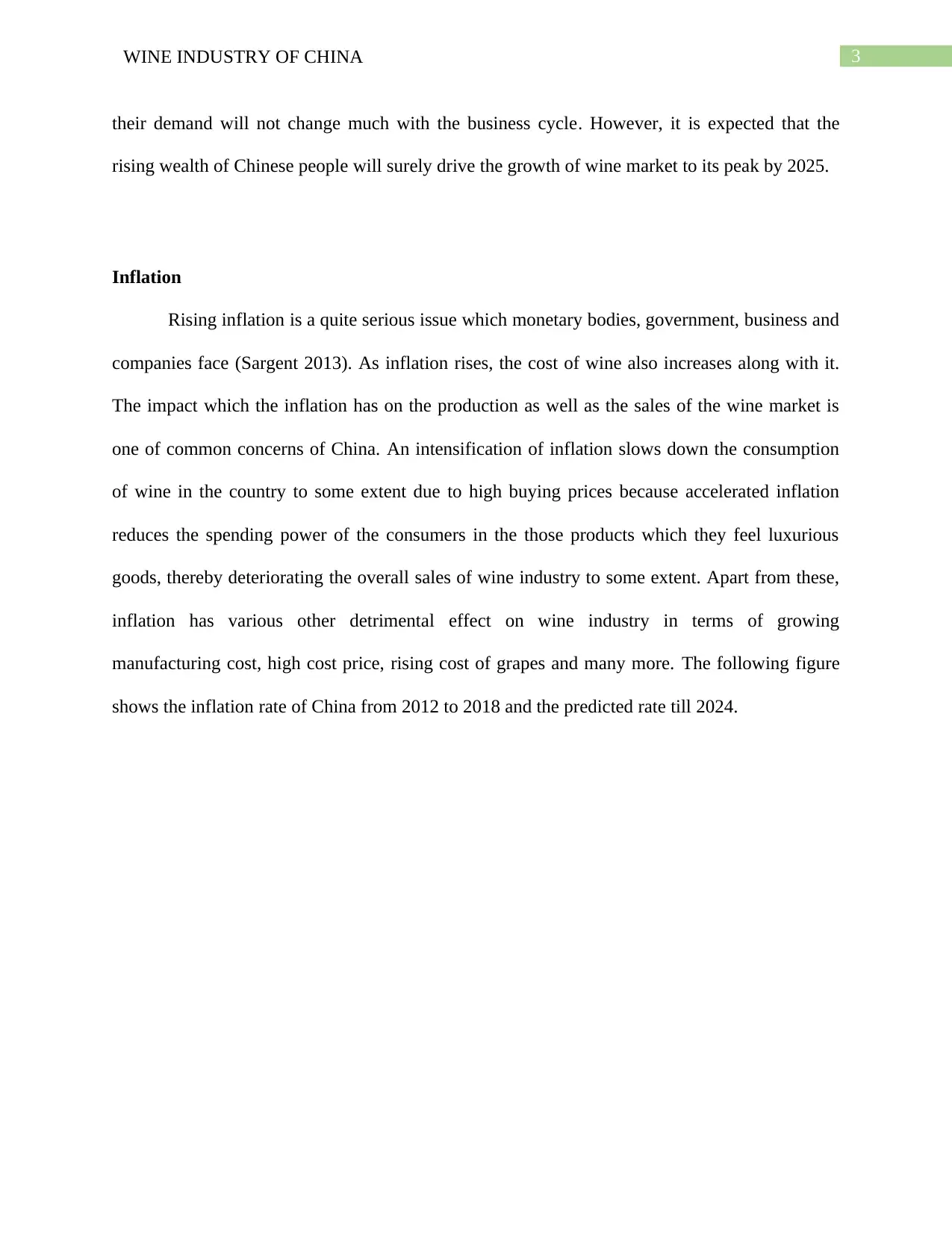
3WINE INDUSTRY OF CHINA
their demand will not change much with the business cycle. However, it is expected that the
rising wealth of Chinese people will surely drive the growth of wine market to its peak by 2025.
Inflation
Rising inflation is a quite serious issue which monetary bodies, government, business and
companies face (Sargent 2013). As inflation rises, the cost of wine also increases along with it.
The impact which the inflation has on the production as well as the sales of the wine market is
one of common concerns of China. An intensification of inflation slows down the consumption
of wine in the country to some extent due to high buying prices because accelerated inflation
reduces the spending power of the consumers in the those products which they feel luxurious
goods, thereby deteriorating the overall sales of wine industry to some extent. Apart from these,
inflation has various other detrimental effect on wine industry in terms of growing
manufacturing cost, high cost price, rising cost of grapes and many more. The following figure
shows the inflation rate of China from 2012 to 2018 and the predicted rate till 2024.
their demand will not change much with the business cycle. However, it is expected that the
rising wealth of Chinese people will surely drive the growth of wine market to its peak by 2025.
Inflation
Rising inflation is a quite serious issue which monetary bodies, government, business and
companies face (Sargent 2013). As inflation rises, the cost of wine also increases along with it.
The impact which the inflation has on the production as well as the sales of the wine market is
one of common concerns of China. An intensification of inflation slows down the consumption
of wine in the country to some extent due to high buying prices because accelerated inflation
reduces the spending power of the consumers in the those products which they feel luxurious
goods, thereby deteriorating the overall sales of wine industry to some extent. Apart from these,
inflation has various other detrimental effect on wine industry in terms of growing
manufacturing cost, high cost price, rising cost of grapes and many more. The following figure
shows the inflation rate of China from 2012 to 2018 and the predicted rate till 2024.
Secure Best Marks with AI Grader
Need help grading? Try our AI Grader for instant feedback on your assignments.
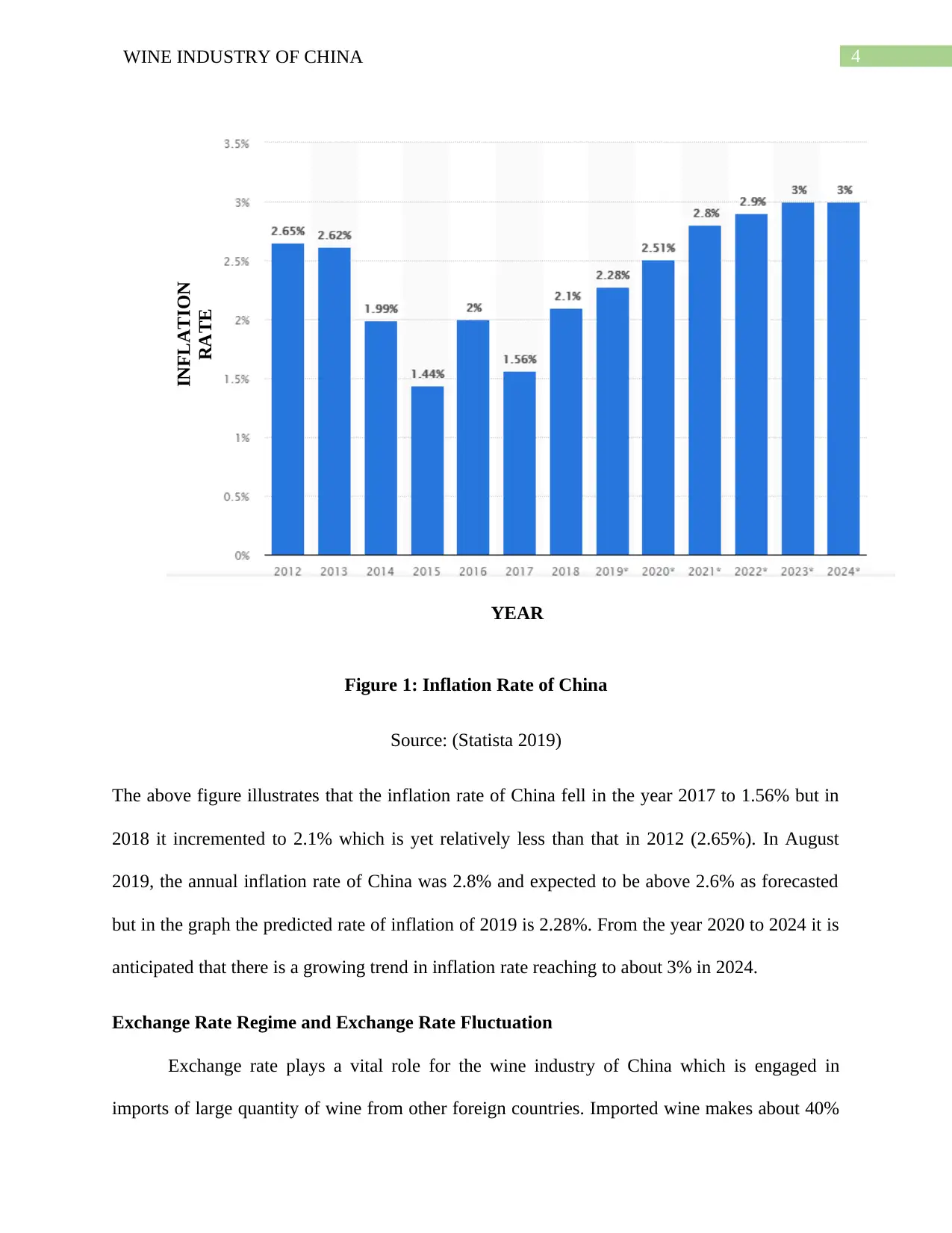
4WINE INDUSTRY OF CHINA
YEAR
INFLATION
RATE
Figure 1: Inflation Rate of China
Source: (Statista 2019)
The above figure illustrates that the inflation rate of China fell in the year 2017 to 1.56% but in
2018 it incremented to 2.1% which is yet relatively less than that in 2012 (2.65%). In August
2019, the annual inflation rate of China was 2.8% and expected to be above 2.6% as forecasted
but in the graph the predicted rate of inflation of 2019 is 2.28%. From the year 2020 to 2024 it is
anticipated that there is a growing trend in inflation rate reaching to about 3% in 2024.
Exchange Rate Regime and Exchange Rate Fluctuation
Exchange rate plays a vital role for the wine industry of China which is engaged in
imports of large quantity of wine from other foreign countries. Imported wine makes about 40%
YEAR
INFLATION
RATE
Figure 1: Inflation Rate of China
Source: (Statista 2019)
The above figure illustrates that the inflation rate of China fell in the year 2017 to 1.56% but in
2018 it incremented to 2.1% which is yet relatively less than that in 2012 (2.65%). In August
2019, the annual inflation rate of China was 2.8% and expected to be above 2.6% as forecasted
but in the graph the predicted rate of inflation of 2019 is 2.28%. From the year 2020 to 2024 it is
anticipated that there is a growing trend in inflation rate reaching to about 3% in 2024.
Exchange Rate Regime and Exchange Rate Fluctuation
Exchange rate plays a vital role for the wine industry of China which is engaged in
imports of large quantity of wine from other foreign countries. Imported wine makes about 40%
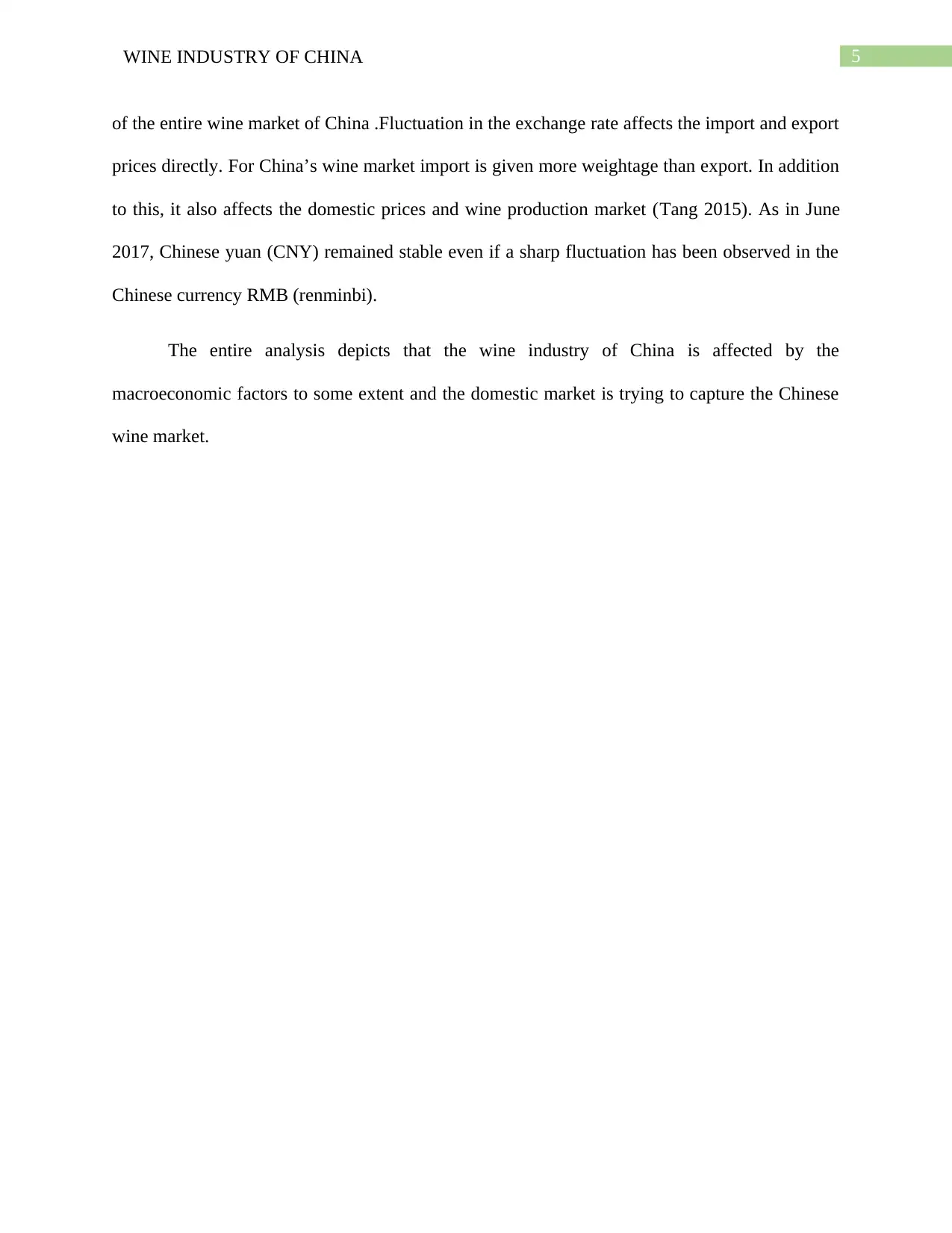
5WINE INDUSTRY OF CHINA
of the entire wine market of China .Fluctuation in the exchange rate affects the import and export
prices directly. For China’s wine market import is given more weightage than export. In addition
to this, it also affects the domestic prices and wine production market (Tang 2015). As in June
2017, Chinese yuan (CNY) remained stable even if a sharp fluctuation has been observed in the
Chinese currency RMB (renminbi).
The entire analysis depicts that the wine industry of China is affected by the
macroeconomic factors to some extent and the domestic market is trying to capture the Chinese
wine market.
of the entire wine market of China .Fluctuation in the exchange rate affects the import and export
prices directly. For China’s wine market import is given more weightage than export. In addition
to this, it also affects the domestic prices and wine production market (Tang 2015). As in June
2017, Chinese yuan (CNY) remained stable even if a sharp fluctuation has been observed in the
Chinese currency RMB (renminbi).
The entire analysis depicts that the wine industry of China is affected by the
macroeconomic factors to some extent and the domestic market is trying to capture the Chinese
wine market.
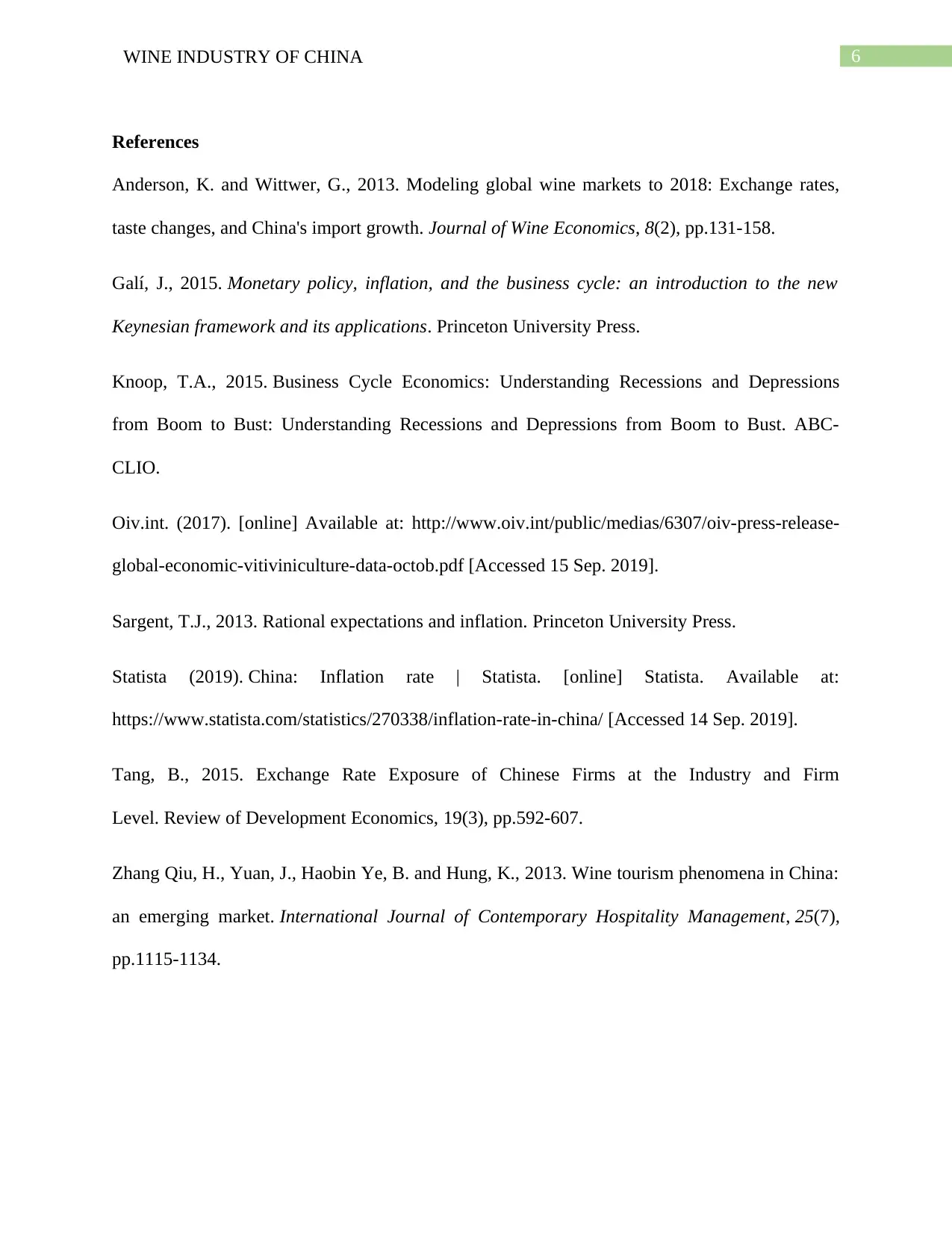
6WINE INDUSTRY OF CHINA
References
Anderson, K. and Wittwer, G., 2013. Modeling global wine markets to 2018: Exchange rates,
taste changes, and China's import growth. Journal of Wine Economics, 8(2), pp.131-158.
Galí, J., 2015. Monetary policy, inflation, and the business cycle: an introduction to the new
Keynesian framework and its applications. Princeton University Press.
Knoop, T.A., 2015. Business Cycle Economics: Understanding Recessions and Depressions
from Boom to Bust: Understanding Recessions and Depressions from Boom to Bust. ABC-
CLIO.
Oiv.int. (2017). [online] Available at: http://www.oiv.int/public/medias/6307/oiv-press-release-
global-economic-vitiviniculture-data-octob.pdf [Accessed 15 Sep. 2019].
Sargent, T.J., 2013. Rational expectations and inflation. Princeton University Press.
Statista (2019). China: Inflation rate | Statista. [online] Statista. Available at:
https://www.statista.com/statistics/270338/inflation-rate-in-china/ [Accessed 14 Sep. 2019].
Tang, B., 2015. Exchange Rate Exposure of Chinese Firms at the Industry and Firm
Level. Review of Development Economics, 19(3), pp.592-607.
Zhang Qiu, H., Yuan, J., Haobin Ye, B. and Hung, K., 2013. Wine tourism phenomena in China:
an emerging market. International Journal of Contemporary Hospitality Management, 25(7),
pp.1115-1134.
References
Anderson, K. and Wittwer, G., 2013. Modeling global wine markets to 2018: Exchange rates,
taste changes, and China's import growth. Journal of Wine Economics, 8(2), pp.131-158.
Galí, J., 2015. Monetary policy, inflation, and the business cycle: an introduction to the new
Keynesian framework and its applications. Princeton University Press.
Knoop, T.A., 2015. Business Cycle Economics: Understanding Recessions and Depressions
from Boom to Bust: Understanding Recessions and Depressions from Boom to Bust. ABC-
CLIO.
Oiv.int. (2017). [online] Available at: http://www.oiv.int/public/medias/6307/oiv-press-release-
global-economic-vitiviniculture-data-octob.pdf [Accessed 15 Sep. 2019].
Sargent, T.J., 2013. Rational expectations and inflation. Princeton University Press.
Statista (2019). China: Inflation rate | Statista. [online] Statista. Available at:
https://www.statista.com/statistics/270338/inflation-rate-in-china/ [Accessed 14 Sep. 2019].
Tang, B., 2015. Exchange Rate Exposure of Chinese Firms at the Industry and Firm
Level. Review of Development Economics, 19(3), pp.592-607.
Zhang Qiu, H., Yuan, J., Haobin Ye, B. and Hung, K., 2013. Wine tourism phenomena in China:
an emerging market. International Journal of Contemporary Hospitality Management, 25(7),
pp.1115-1134.
1 out of 7
Related Documents
Your All-in-One AI-Powered Toolkit for Academic Success.
+13062052269
info@desklib.com
Available 24*7 on WhatsApp / Email
![[object Object]](/_next/static/media/star-bottom.7253800d.svg)
Unlock your academic potential
© 2024 | Zucol Services PVT LTD | All rights reserved.



